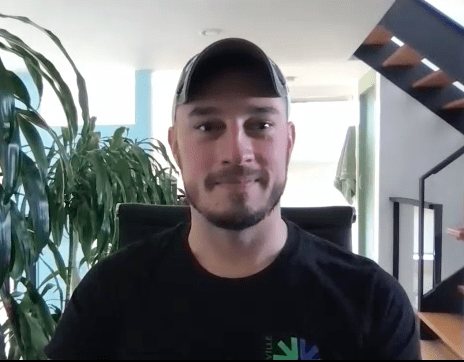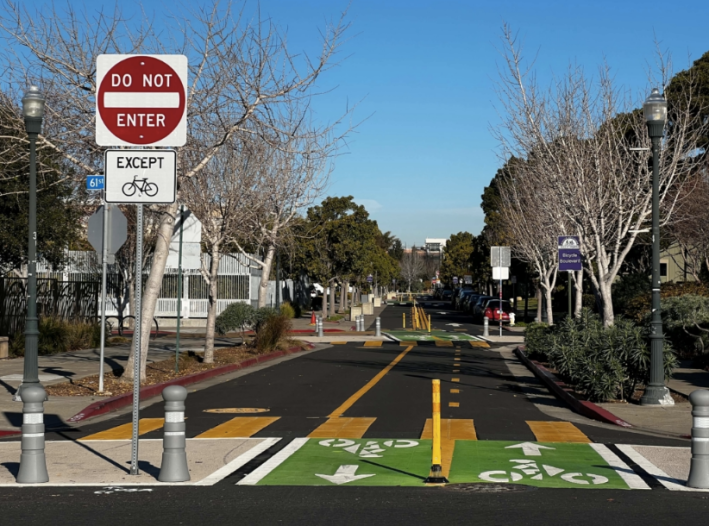What Can a Mayor Do to Make a City More Livable?
5:22 PM PST on January 19, 2022

Emeryville Mayor and Bike Rider John Bauters
"In most cities, mayors don't have a lot of powers," Emeryville Mayor John Bauters told Streetsblog in a recent interview. He sees himself as a part of a team with the city council, which holds most of the decision-making power in this small city wedged between Oakland, Berkeley, and the San Francisco Bay.
But what a mayor can do is "set the tone," he said. "The mayor is the person who speaks on behalf of what the community wants." That means more than being a figurehead; a mayor "rallies people, brings them into community with each other, paves the path for [working together], and identifies what the city is going to do to either address a concern, or rectify an issue, or celebrate an accomplishment."
"The same thing is true when it comes to the very sexy world of bike infrastructure," he adds. "My personal point of view is that a mayor is somebody who not just cheer-leads, but also shows people the path that's possible, and then encourages people to get on that path - that bike path - and help move the city towards what it wants to be."
In addition, mayors of the myriad cities in the Bay Area have the opportunity to weigh in on regional matters. Bauters, for example, is currently also the vice chair of the Alameda County Transportation Commission, and serves on the board of the local air quality management district. There he works regional transportation, clean energy, and emissions reduction projects and issues.
"I can speak out about bike infrastructure and about pedestrian safety, and I can help move our funding priorities and the dialogue in the county towards a more inclusive, multimodal system," he said. At the air district, he makes a point of "modeling" emissions reductions by riding his bike to the meetings - even though the missing bike path on the western span of the Bay Bridge means a more-than-forty-mile ride circling the north end of the San Francisco Bay to get there from Emeryville.
That kind of action can be important symbolically. It says to people that there are leaders "who have a shared vision for climate action, who believe that bikes are a vehicle of change, and that walking and biking are not just healthy for ourselves but for the environment and for others."
And electing people who prioritize riding their bikes "puts new people into the discussion that weren't previously part of it - but that still have to pay for the funding decisions made."
While bicycle fans might be used to feeling dismissed as an opinionated minority, having champions in leadership positions can shift that. A "bike person" on a regional board, for example, can make sure that, at the very least, board members are reminded how important bicycling is for planetary and individual health. When no one on those decision-making bodies understands biking, that message goes missing.
Bauters describes having to remind his colleagues of their windshield perspective.
"People have said: Well, you just feel that way or think that way because you bicycle. And I say, so look at the rest of you - you all drive. And the reason we keep spending billions on freeways is because it's what you do. I don't want to spend billions on freeways, because it doesn't benefit me."
"So of course I want to build a bike bridge between Oakland and Alameda, and of course I want to have an East Bay Greenway - because that's what people use. You just haven't ever had somebody sit on this board with you who had that experience," he said.
"I was speaking to a couple of non-bicyclists about a plan for a bike project. And they said to me: "Well, you know, maybe we could do it partway - we could maybe take cars off of half of that space," he said. "The mindset is constantly that we need to share it with cars. But whenever we build a road, do we always have a conversation about how we have to make sure we keep half of it for bikes? We don't do that. The predisposition is that everyone has to use cars. We don't ever ask that question the other way around. And we should."
"Let's figure out how to actually put parity into what we build - because for a lot less money, you could put a lot more people on my greenway that you could with funding for three miles of your freeway."
Bauters believes strongly - based on his own childhood experience of riding his bike to kindergarten - that when young people are allowed the freedom to bike safely, they will never need to give it up. That is kind of his aim in Emeryville - not so much to force anyone to ride a bike instead of drive a car, but to be able to do so.
"People ask me what my agenda is, but I don't have an agenda," said Bauters. "Other than joy."
"I don't believe in going out and convincing people to do something; rarely will you ever hear me say it's got to be this way or that way," he said. "I'm not doing things to change your mind. I'm not trying to actually force anybody onto a bicycle. What I'm offering is a space to let people find it for themselves."
"When I was a child, my parents gave me a dirt bike. And right next to our house, there was this huge field that had all kinds of dirt hills and stuff. And I would just go out and I would bike and I would catch frogs and mice and watch the sunset and play in the creek, and I took my bike everywhere. And I would come home and my mom would make me a peanut butter and honey sandwich. And it sounds like this bucolic little romantic mid-America thing, but the truth is, I still think about that. In my 40s. And I still come home and make a peanut butter and honey sandwich."
"And I still ride my bike wherever I want and go out to the water and I do whatever I want because I know how much joy I get with that."
Joy gets lost when people can't relax. One of the projects Bauters and his allies on the council were able to get through during COVID was a major reconfiguration of Doyle Street, making it a mostly car-free street that connects to the greenway bicycle path cutting through Emeryville. Because there is so little car traffic on that one street now - basically, it was a "Slow Street" or "Safe Street" made permanent - families can ride along it without fear of being passed by fast-moving cars.

"If a person has to bike with their kid, and there's cars going in the other direction, or we've got police at the ends of it to keep people safe, they don't actually just have the ability to focus on their experience with the bicycle," said Bauters. "What we need to give people is car-free spaces with just their bicycle and their family or their friends and a sunny afternoon, and let them be themselves without the noise of traffic and the honking of a horn and the lights of a police car at the end of the street. If we give people that space and that experience, we are changing their hearts and minds."
"They may not become a bike commuter," but new possibilities open up. They take their children to ride the Bay Trail on the weekends; they see their child loves something - or they do. "And now they actually have to care about whether that bike lane goes in, and then they're thinking about it and they're emailing me and they're telling me - like these parents do already with Doyle street - 'my child loves biking to Doyle Park.' 'My wife always drove but now she bikes with them.'"
"That is how you make change; not because I had an agenda to make everyone on the north side of my city bicycle that route, but people found it because we left it there for them."
People begin to realize things they can't imagine when they're stuck in cars - things like how fun a scooter can be, or how fast it is to get around by bike compared to driving and parking and walking someplace. "That's the kind of things that break through people's minds," said Bauters. "I'm not trying to actually force anybody onto a bicycle. What I'm offering is a space to let people find it for themselves."
Bauters has lots more ideas for Emeryville. The city is planning a major redesign of 40th Street, a major thoroughfare that passes a large parking, er, shopping mall. The street will get a road diet with transit-only lanes, a two-way cycle track, and pedestrian bulb-outs at every intersection. The city is also redoing its active transportation plan - due out later in the spring - in which they identify several streets they want to make car-free. They are also working on a project suggested by Bauters' colleague Ally Medina to close individual sections of existing bike routes to make them into plazas and parks. "We are going to deprioritize those streets for cars by essentially cutting traffic out of them in a couple places, so that they can be dedicated to people who want to sit outside and enjoy. We'll turn the street space into something else, and we'll have bike paths going through for a largely car-free route going forward."
"It's about creating the infrastructure and the incentives that actually help people make different choices," said Bauters.
This interview was condensed and edited from an interview for BikeTalk. Check BikeTalk early next week to listen to the entire conversation.
Read More:
Stay in touch
Sign up for our free newsletter
More from Streetsblog San Francisco
Weekend Roundup: Bancroft Lane Gets Concrete, Party in Downtown S.F.
...and the Bay Bridge to get its lights back
Richmond-San Rafael Bridge Bike Lane Will Need Support
There's no evidence the bike lane contributes to congestion on the bridge
Update on Oakland DOT’s Lakeshore Protected Bike Lane Project
Public seems fairly positive and accepting towards the coming project. Let's hope it stays that way




